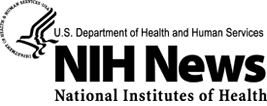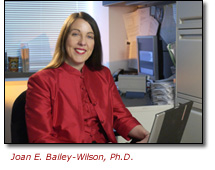Last updated: July 24, 2012
NHGRI Names Co-Chiefs of Inherited Disease Research Branch

NHGRI Names Co-Chiefs of Inherited Disease Research Branch
Drs. Joan Bailey-Wilson and Alexander Wilson Will Lead Efforts To Use Statistical Tools to Find Genetic Keys to Common Diseases
 BALTIMORE, Tues., Jan. 10, 2006 — The National Human Genome Research Institute (NHGRI) today announced the appointment of a husband-and-wife scientific team, Joan E. Bailey-Wilson, Ph.D., and Alexander F. Wilson, Ph.D., as the new co-chiefs of its Inherited Disease Research Branch, one of the seven research branches in NHGRI's Division of Intramural Research.
BALTIMORE, Tues., Jan. 10, 2006 — The National Human Genome Research Institute (NHGRI) today announced the appointment of a husband-and-wife scientific team, Joan E. Bailey-Wilson, Ph.D., and Alexander F. Wilson, Ph.D., as the new co-chiefs of its Inherited Disease Research Branch, one of the seven research branches in NHGRI's Division of Intramural Research.
"We are excited that these outstanding scientists have agreed to take the helm of the Inherited Disease Research Branch. Their vision and expertise will advance our efforts to unlock the genetic mysteries of common diseases," said NHGRI Scientific Director Eric. D. Green, M.D., Ph.D.
Located at the Bayview campus in Baltimore, the Inherited Disease Research Branch develops and applies new methods and tools to identify the genetic contributions to disease, particularly in common, genetically complex disorders, such as cancer and diabetes. Most of the branch's researchers are statistical geneticists, a research specialty that combines statistics, genetics and computer science.
The Inherited Disease Research Branch also serves as NHGRI's link to the Center for Inherited Disease Research, a federally supported facility located at The Johns Hopkins University in Baltimore. The center provides high-throughput genotyping to scientists at NIH and other research institutions around the world.
Drs. Bailey-Wilson and Wilson are currently senior investigators in the branch. Dr. Bailey-Wilson is head of the Statistical Genetics Section, while Dr. Wilson is head of the Genometrics Section.
"Given the vast amounts of genomic data becoming available, the Inherited Disease Research Branch is destined to become even more important in coming years. Not only will our investigators search for genes themselves, but we will develop innovative methods and software to guide other genome researchers in their hunts for disease-associated genes," said Dr. Bailey-Wilson.
Dr. Wilson agreed, "There is an urgent need to bolster the statistical 'toolkits' used by the genome research community. Our branch must work to develop new methodologies that are easier to use and that can handle the massive amount of data now being generated by molecular geneticists."
 Both natives of Baltimore, Drs. Bailey-Wilson and Wilson met during their senior year at Western Maryland College, now known as McDaniel College, in Westminster, where they were performing separate genetic research projects under the same mentor, Jean Kerschner, Ph.D. "We got married while we were graduate students at Indiana and have been a three-career couple - his, hers and ours - ever since," Dr. Wilson said.
Both natives of Baltimore, Drs. Bailey-Wilson and Wilson met during their senior year at Western Maryland College, now known as McDaniel College, in Westminster, where they were performing separate genetic research projects under the same mentor, Jean Kerschner, Ph.D. "We got married while we were graduate students at Indiana and have been a three-career couple - his, hers and ours - ever since," Dr. Wilson said.
Dr. Bailey-Wilson received a B.A. in 1975 from McDaniel College and a Ph.D. in Medical Genetics in 1981 from Indiana University Medical Center in Indianapolis. Along with colleagues at other institutions, Dr. Bailey-Wilson's group has been engaged in an intense effort to find genes that contribute to the development of lung cancer. In a study published in the American Journal of Human Genetics in September 2004, Dr. Bailey-Wilson and other members of the Genetic Epidemiology of Lung Cancer Consortium reported strong evidence for the presence of a major lung cancer susceptibility gene on chromosome 6 that appears to act with smoking to increase lung cancer risk. The consortium is now working on pinpointing the exact gene and defining the mutations that play a role in the disease. They are also searching for other genes that may affect the risk for lung cancer.
Dr. Bailey-Wilson's group is also heavily involved in the search for genes that influence vision disorders, such as glaucoma, myopia and cataracts. They work with numerous collaborators in several large population- and family-based studies of these disorders, and have presented these results in several recent papers and at scientific meetings of organizations such as the International Genetic Epidemiology Society and the American Society of Human Genetics. In an attempt to identify these genes, Dr. Bailey-Wilson's group is using new data and technologies related to the International HapMap Project, a six-nation effort that recently produced a comprehensive catalog of human genetic variation.
Dr. Wilson received a B.A. from McDaniel College in 1975 and a Ph.D. in Medical Genetics from Indiana University in 1980. His research covers a wide range of disorders, including obesity and cardiovascular disease. His group recently determined that at least some cases of extreme curvature of the spine - referred to as scoliosis - are linked to a region on the X chromosome. He and his colleagues are now trying to pinpoint the exact gene(s) responsible for scoliosis, which affects about one in 200 people.
In addition, Dr. Wilson combined two traditional tests in a way that increased the ease and significantly reduced the cost of testing for the heritability of quantitative traits, such as blood pressure. The combined methodology is called Regression of Offspring on MidParent (ROMP). He also created a software program that enables researchers to build better models to simulate and analyze the varying contributions of genetic and environmental factors to a specific disease in a given population. More than 70 institutions in at least 14 countries are now using this Genometric Analysis Simulation Program (GASP) software as a teaching tool and to test new methodologies.
High-resolution photos of Drs. Bailey-Wilson and Wilson are available at: www.genome.gov/dmd.
NHGRI is one of the 27 institutes and centers at the National Institutes of Health, an agency of the Department of Health and Human Services. The NHGRI Division of Intramural Research develops and implements technology to understand, diagnose and treat genetic diseases. Additional information about NHGRI can be found at www.genome.gov.
Contact:
Geoff Spencer, NHGRI
spencerg@mail.nih.gov